The FTSE remains in no man’s land
The index is caught between long-term resistance and short-term support. John C Burford watches the charts for signs of a break-out.
On Wednesday, I put the FTSE in no man's land. Since then it has tried to advance out of it, but on Friday it was beaten into a retreat by superior forces.
Just to quickly refresh your memory, this was the chart last Wednesday:
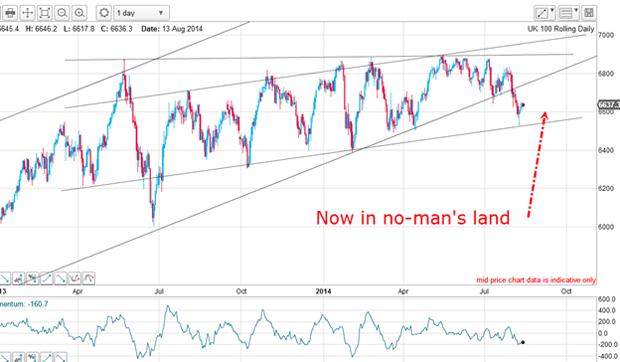
I called this region no man's land because it lies between the resistance of the long-term tramline and the support of the shorter-term tramline.
MoneyWeek
Subscribe to MoneyWeek today and get your first six magazine issues absolutely FREE

Sign up to Money Morning
Don't miss the latest investment and personal finances news, market analysis, plus money-saving tips with our free twice-daily newsletter
Don't miss the latest investment and personal finances news, market analysis, plus money-saving tips with our free twice-daily newsletter
And breaking out of this zone would be a significant event.
So this morning, I want to assess the current position, because a correct reading will help swing traders determine their next trade.
The tell-tale sign of a changing trend
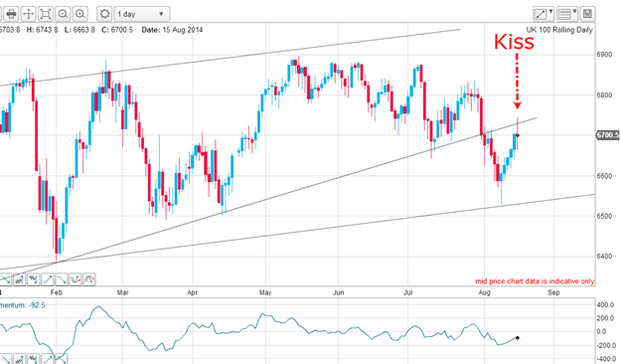
Lo and behold, the rally, which was underway on Wednesday, extended further into Friday and planted a kiss (with slight pigtail) on my wedge line. Isn't that pretty?
That kiss beautifully illustrates the principle that when a tramline or a wedge line has been broken, that event transforms it into its opposite. The wedge line had been a line of support for many months until the clear break on 1 August. That break transformed it into a line of resistance.
Now, instead of going long on the wedge line prior to the break, the correct trade is to go short. The trend has changed and the kiss is the tell-tale signal.
The kiss is actually one of my favourite trade setups. It offers a low risk opportunity to enter in the new direction of travel.
Now, any short trades taken at the kiss can be protected by a close stop. Even if the market does resume its rally, only a small loss will be taken. Remember, there are no 100% sure things in trading, despite our best efforts at analysing the market.
Did the market reach a Fibonacci level?
This was the chart:
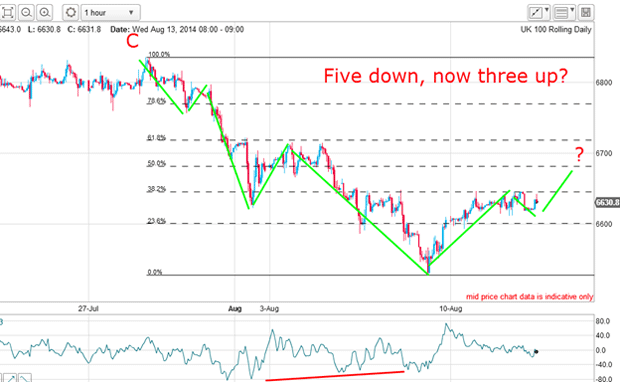
Did I get my three up, and did the market reach a Fibonacci level?
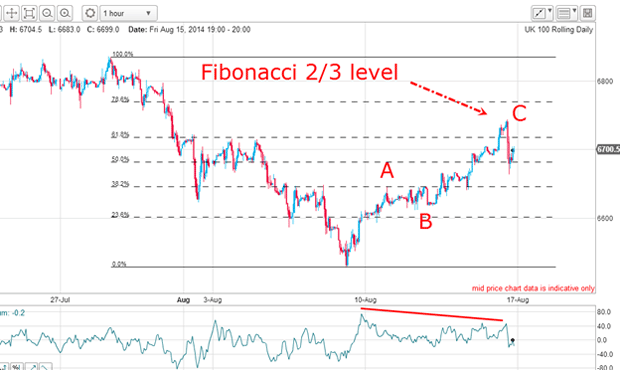
Yes indeed. I have three up and the C wave ended at the Fibonacci 2/3 (67%) level. Remember, the ratio 2/3 is also a Fibonacci level despite its absence on the trading tool provided by many platforms.
You should always keep in mind that 1/3 and 2/3 are legitimate Fibonacci levels and reversals can occur at either, although reversals from the 1/3 level are quite rare.
Interestingly, over in the Dow the rally carried to the Fibonacci 62% level.
Will the FTSE break out of no-man's land?
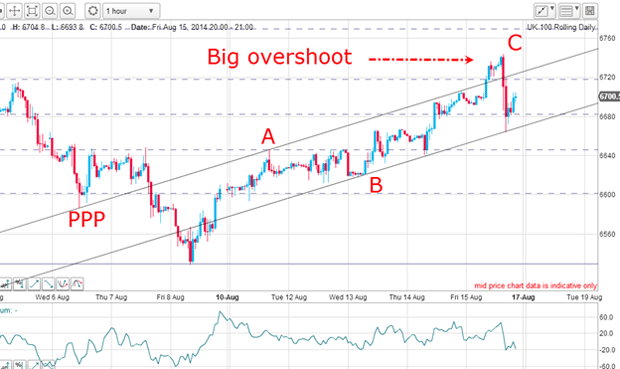
I have excellent tramlines with a PPP (prior pivot point) on the upper line, which has that large overshoot. Remember, an overshoot usually heralds a sharp move in the opposite direction, which did occur right on cue. It was the steepest setback of the entire rally.
Also note that the sharp decline on Friday out of the overshoot was reversed exactly on the lower line a significant verification of that line as a valid line of support.
That means that a break of that lower line would now be a significant - and another tradable - event.
Get the latest financial news, insights and expert analysis from our award-winning MoneyWeek team, to help you understand what really matters when it comes to your finances.
John is is a British-born lapsed PhD physicist, who previously worked for Nasa on the Mars exploration team. He is a former commodity trading advisor with the US Commodities Futures Trading Commission, and worked in a boutique futures house in California in the 1980s.
He was a partner in one of the first futures newsletter advisory services, based in Washington DC, specialising in pork bellies and currencies. John is primarily a chart-reading trader, having cut his trading teeth in the days before PCs.
As well as his work in the financial world, he has launched, run and sold several 'real' businesses producing 'real' products.
-
 Why you fear money – and how to fix it: MoneyWeek Talks
Why you fear money – and how to fix it: MoneyWeek TalksPodcast MoneyWeek's digital editor, Kalpana Fitzpatrick, speaks to financial psychotherapist Vicky Reynal about how to change your money mindset for the better.
-
 How cancelling unused direct debits could boost your pension by £37,000
How cancelling unused direct debits could boost your pension by £37,000A new year refresh of your spending could save you money and help boost your pension pot.